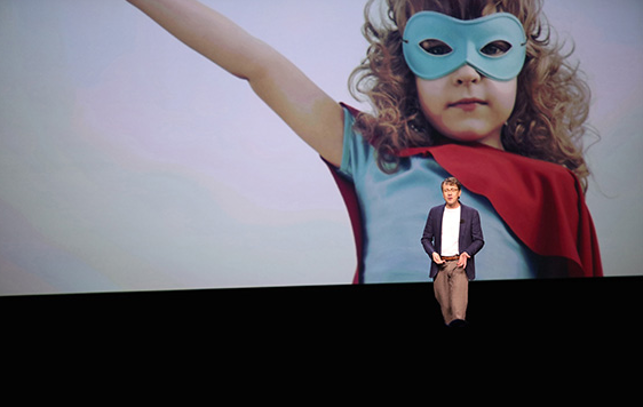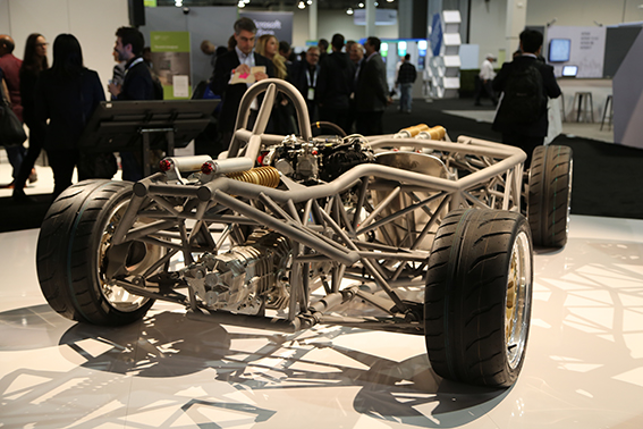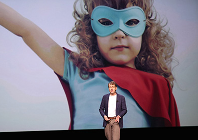
Autodesk’s chief technology officer, Jeff Kowalski
#1 Machine learning
Autodesk’s enigmatic chief technology officer (CTO), Jeff Kowalski, traditionally undertakes the first keynote talk and always gives a thoughtful take on where design technology is going.
This year’s talk was great; covering design tools from the ancients to the future. In fact, many of the prospective technologies he has talked about in the past five years are now becoming reality, especially the use of robots and machine learning.
These powerful tools are now combining to give designers ‘infinite expressability’ which will help shape the future by amplifying their ideas.
Machines have gone from being taught how to play games by programming, to teaching themselves. Machines now learn in ‘machine time’ so they can learn something by running thousands, millions of scenarios simultaneously and learning from the output.
Kowalski went so far as to say that machines are now starting to be creative and being able to create new works of art and new designs.
He went on to talk about Project Dreamcatcher, a generative design system that is being worked on in Autodesk Research. The Dreamcatcher technology, which has been shared with only a handful of customers, has been consuming millions of 3D models and learning from typically designed and manufactured parts. It has been used in aerospace prototypes already and this year we were given the redesign of a car suspension component. We also saw a new optimised geometry solution and a version with internal lattice structure, learnt from how bones have internal structures.
The big news is that Dreamcatcher becomes available for all to use next year. This could be a serious game changer in the way we design, where CAD actually does aid the design process.
Kowalski’s presentation can be seen here
#2 Dreamcatcher & Hack Rod
One of the most impressive examples of how Autodesk’s research into machine learning is aiding design is Hack Rod, a digital industrial design company.
Felix Holst of the company was on hand to explain how a chassis had been designed using Dreamcatcher to optimise the weight and strength of the car body, based on telemetry data of a previous generation car, which was fed into Dreamcatcher.
The result was an incredibly lightweight vehicle with unusual lattice work. Felix told us that he also used Virtual Reality (VR) to explore how the transmission and gearbox would fit into the chassis before any fabrication had taken place. By using VR, the actual installation went without a hitch.
Looking ahead Felix thinks that, based on chassis designs, customers might be able to design their own car body and have the software optimise the design to work on the available running gear.
The software will always make sure it’s a viable design and all the mount points would fit. Digital design and fabrication are going to make a big impact on what is possible in the not too distant future.

Hack Rod’s generatively designed chassis — perhaps the best example of machine learning and how it applies to design we’ve seen yet
#3 The products were back on stage
The last couple of years have seen Autodesk shy away from showing off its products in any major form during the event’s keynote session. With such changes across all aspects of its business (and the move to new cloud-based solutions), 2016’s Autodesk University saw a welcome return to a product showcase on the second day with the major groups within Autodesk’s arsenal taking turns on the stage.
Firstly, the Fusion team presented a product demo that showed off where Fusion 360 is heading, focussing on a demo centred on the BAC Mono, a British automotive company and one of Autodesk’s flagship customers. (Click here to read what’s coming up in Fusion 360).
Fusion was followed by Autodesk’s AEC group, which unveiled where it thinks the future of Revit will go. (If you want to learn more about Autodesk’s future plans for the architectural industry, then check out the next issue of DEVELOP3D’s sister publication AEC Magazine, which is available for free download at aecmag.com).
Manufacturing and AEC were then followed up by a presentation from the Media and Entertainment group. The M&E groups presentations are always good to watch, but what struck us was that while all three presentations focussed on very different industries, there are many common challenges; time pressures, collaboration with geographically dispersed teams and more accessible toolsets. And let’s be honest, when the platform for that is called Shotgun, you know you’re in Hollywood territory.
#4 Exhibition floor
Walking the exhibition floor is now one of the most enjoyable parts of AU as there is plenty to see and do — hands on technologies, innovative products from customers, new hardware, new software, wearables, drones, robots, CNC machines and many Autodesk developers with add-ons for Autodesk products.
Historically, back in the days of AutoCAD, these would be simple things like symbol libraries and plotting tools but nowadays, there are many feature-rich products that can radically benefit the design process like Arup’s crowd simulator, MassMotion or drag and drop VR for Revit with IrisVR.
Autodesk brought two of its large robot arms to perform live 3D printing on a large scale. Think Westworld! Fenced off from the public, you could watch the robot go through its paces laying down layers of black plastic, building all sorts of 3D components.
Just over on the next aisle were some large metal 3D prints, showing how Dreamcatcher optimisation reduced the weight of the suspension arm dramatically and a huge metal fin structure which was 3D printed for a roof design. Hack Rod’s chassis took centre stage, as it should, and there were many wooden chairs again designed using the Dreamcatcher optimisation algorithm.
#5 Virtual Reality is coming
VR is a hot topic at the moment and Autodesk is currently researching its potential uses.
While many may consider the VR experience to be an end in itself, Autodesk is looking at how we can design while in a VR environment, not just to explore the model but to model and shape intuitively.
There was a dedicated space for some hands-on VR booths running Autodesk’s experimental VR tools which were working with HTC Vive headsets. Using the VR kit it was possible to interact with, edit and draw on a 3D model of a car, while looking at meta data and design feedback.
While embryonic, it gave a clear indication that Autodesk feels that VR applications can play a role, not just in the sharing the experience of a design, but also to do design work in a virtual space.
#6 Autodesk has teamed with Leica
A major surprise came in the small but perfectly formed shape of a joint venture from Leica and Autodesk, combining Recap on an iPad with what has to be one of the most gorgeously designed, highly portable laser scanners we have ever seen.
Leica Geosystems’ new BLK360 is a self-levelling, miniaturised 3D imaging laser scanner which weighs about 2lbs and easily fits into a bag. It captures fullcolour panoramic images overlaid on a high accuracy point cloud, accurate at distances up to 60 metres.
The device captures HDR images, as well as thermal images, and has built-in lights so it can work in low light.
Operation is extremely easy with a one-button press. The device was described as waterproof and could be mounted on a tripod, on a ceiling or on its ingenious built-in stand. In fact the design of the device and its dome carrying case is nothing short of exquisite.
From the outset the new scanner was designed to work with Autodesk’s ReCap 360 Pro and the new ReCap 360 Pro app for iPad. As there’s no display on the scanner, control is provided within Recap on the iPad Pro.
There is no user accessible storage on the scanner; all data is sent to the iPad over WiFi. Typically a full 360 degree capture will take three minutes. The app filters and registers scan data in real-time. After capture, ReCap 360 Pro enables point cloud data transfer to a number of CAD, BIM, VR and AR applications. BLK360 and Autodesk ReCap 360 Pro Bundle will be available to order in March 2017.
The anticipated bundle suggested retail price is $15,990/€15,000.
au.autodesk.com
6 things we learned at Autodesk University
Default






